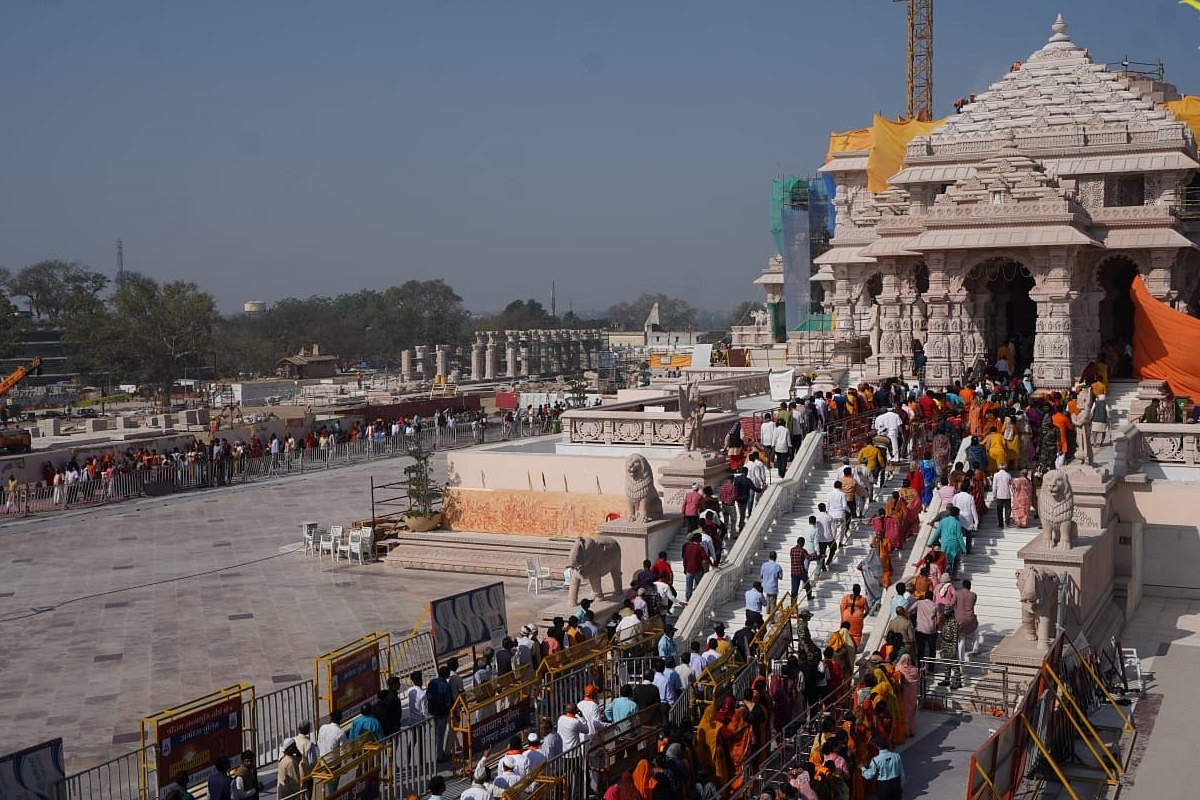Commentary
The Long Struggle For Dharma: Ayodhya Is Cause For Celebration, Not Complacency
- A critical battle is won. The larger conflict still rages.

Queues of devotees at the Ayodhya Ram Janmabhoomi Mandir (Shri Ram Janmbhoomi Teerth Kshetra/X)
As the sun rays touched the sacred murti of Shri Ramlalla or the infant Shri Ram at Ayodhya on Shri Ram Navmi of the year 2024 of the Common Era, we became the first generation in five centuries to witness this grand celebration at this sacred spot.
Five centuries of waiting; five centuries of resistance; five centuries of righteous battles; five centuries of balidaan and we have the grand Shri Ram Temple at Ayodhya.
The joy and the sense of victory should make us also ponder over the path we travelled, particularly after 15 August 1947.
We saw Hindus who wanted to build the temple massacred in the streets of Ayodhya. We saw the bodies of promising youth of 1990 hooked to sand bags and thrown into Sarayu river, their dignity denied even in death.
Three years later, the person who ordered for the bullets to be fired at the youth would become the chief minister of the very same state. Even today, his dynast-political party commands the following of quite a large number of Hindus.
Imagine in any other religion, a politician who massacres his own co-religionists in one of the most sacred of the cities of that religion. His political career would be doomed for ever. In India, his party is still a contender for power.
The reason is because Hindus, after momentary high spirited unity, tend to disunite and vote based on caste distinctions, such as Brahmins versus non-Brahmins, Dalits versus non-Dalits, Yadavs versus non-Yadavs, and so forth.
In a vibrant and healthy democracy, such vote-banks may be considered as representing the legitimate aspirations of the communities for representative power in the state machinery. But in a Hindu society which is still a society under siege, as Sitaram Goel said, such identity politics is an instrument that can be weaponised against Hindus.
Then how was the Ayodhya success achieved?
Though the verdict in favour of the temple was granted by the Supreme Court and unanimously at that, had it been not for Narendra Modi’s second term, it is highly unlikely that temple would have been a reality. And how did Modi make it a second time, given the tendency of Hindu voters to dissipate along caste lines even with gentle nudges?
The answer may lie in the Modi government's popular schemes, from toilets construction to cooking gas, from electrification to tapped water to every household. The effective implementation of these programmes, with minimal bureaucratic hurdles and graft, created a unique voter base, cutting across caste-identities.
The near-universal coverage of these schemes accorded benefits not in the form of freebies but as practical tools to propel their own further development.
When such tangible and inclusive welfare unites people, there is a civilisational undercurrent to it. This created a latent, subconscious Hindu unity.
It was on the back of such efficient executions of programmes that Modi could bring in his second term and the second term assured the advent of Ram Mandir in all its glory.
But this is only a battle that was won. The war is raging on.
In 2005, I was standing before a pillar. It was surrounded by bushes. A well-tended volleyball court for local village boys almost encroached upon the pillar. But the pillar itself was neglected.
The pillar commemorated the victory of Travancore forces over the Dutch. But as the victory pillar, with a Dharmic conch on its top stands, it is surrounded by buildings mostly belonging to Catholic church. Gigantic crosses adorn the buildings. The pillar stands as an oddity.
The naval battle was of course won by Travancore, but the civilisational war in this territory has been lost.
The Ayodhya temple is a significant victory in the Dharmic-political battle. It was possible because of Hindu unity at various levels and through a long period. However, the forces hostile to Dharma are not idle.
We cannot afford to allow the construction of the Ayodhya Ram Temple to become like the victory pillar of Travancore. Towards that end, to paraphrase Veer Savarkar, Hindus need to democratise and unite Hindu society and Hinduise Indian politics.
Hindus need to work towards a situation where right or left, Congress, Communist or BJP, Hindutva is taken as axiomatic for Indian politics. That is the best assurance that the Shri Ram Temple of Ayodhya will stand in all its glory for thousands of years to come and will be untouched by any invader, from any foreign culture.
We are the generation that witnessed Shri Ram's return to Ayodhya. We should also be the generation to take the necessary steps so that Shri Ram may never leave his city again, while Shri Krishna and Mahadeva will have their sacred spaces liberated.
Support Swarajya's 50 Ground Reports Project & Sponsor A Story
Every general election Swarajya does a 50 ground reports project.
Aimed only at serious readers and those who appreciate the nuances of political undercurrents, the project provides a sense of India's electoral landscape. As you know, these reports are produced after considerable investment of travel, time and effort on the ground.
This time too we've kicked off the project in style and have covered over 30 constituencies already. If you're someone who appreciates such work and have enjoyed our coverage please consider sponsoring a ground report for just Rs 2999 to Rs 19,999 - it goes a long way in helping us produce more quality reportage.
You can also back this project by becoming a subscriber for as little as Rs 999 - so do click on this links and choose a plan that suits you and back us.
Click below to contribute.
Latest